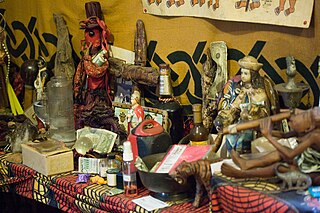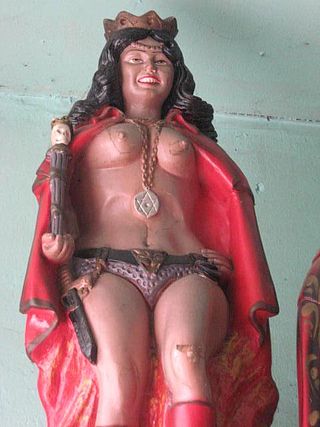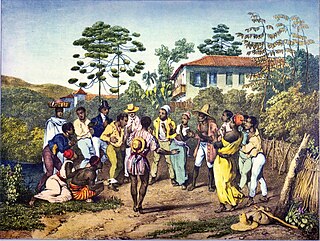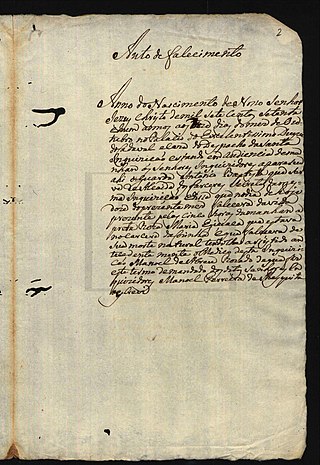Related Research Articles

Vodun is a religion practiced by the Aja, Ewe, and Fon peoples of Benin, Togo, Ghana, and Nigeria.

Umbanda is a religion that emerged in Rio de Janeiro, Brazil in the 1920s. Deriving largely from Spiritism, it also combines elements from Afro-Brazilian traditions like Candomblé as well as Roman Catholicism. There is no central authority in control of Umbanda, which is organized around autonomous places of worship termed centros or terreiros.

Candomblé, previously known as batuque, is an African diasporic religion with music and dance, that developed in Brazil during the 19th century. It arose through a process of syncretism between several of the traditional religions of West Africa, especially those of the Yoruba, Bantu, and Gbe. There is some influence from the Roman Catholic form of Christianity. There is no central authority in control of Candomblé, which is organized around autonomous terreiros (houses).

The predominant religion in Brazil is Christianity, with Catholicism being its largest denomination. In 1891, when the first Brazilian Republican Constitution was set forth, Brazil ceased to have an official religion and has remained secular ever since, though the Catholic Church remained politically influential into the 1970s. The Constitution of Brazil guarantees freedom of religion and strongly prohibits the establishment of any religion by banning government support or hindrance of religion at all levels.

Candomblé Bantu is one of the major branches (nations) of the Candomblé religious belief system. It developed in the Portuguese Empire among Kongo and Mbundu slaves who spoke Kikongo and Kimbundu languages. The supreme and creative god is Nzambi or Nzambi a Mpungu. Below him are the Jinkisi or Minkisi, deities of Bantu mythology. These deities resemble Olorun and the other orishas of the Yoruba religion. Minkisi is a Kongo language term: it is the plural of Nkisi, meaning "receptacle". Akixi comes from the Kimbundu language term Mukixi.

African diaspora religions, also described as Afro-American religions, are a number of related beliefs that developed in the Americas in various nations of the Caribbean, Latin America and the Southern United States. They derive from traditional African religions with some influence from other religious traditions, notably Christianity and Islam.
Batuque may refer to:

Macumba, also spelled Makumba, is a term that has been used to describe various religions of the African diaspora found in Brazil, Argentina, Uruguay, and Paraguay. It is sometimes considered by non-practitioners to be a form of witchcraft or black magic.
Kumina is an Afro-Jamaican religion. Kumina has practices that include secular ceremonies, dance and music that developed from the beliefs and traditions brought to the island by Kongo enslaved people and indentured labourers, from the Congo region of West Central Africa, during the post-emancipation era. It is mostly associated with the parish of St. Thomas in the east of the island. However, the practice spread to the parishes of Portland, St. Mary and St. Catherine, and the city of Kingston.
Quimbanda, also spelled Kimbanda, is an Afro-Brazilian religion practiced primarily in the urban city centers of Brazil. Quimbanda practices are typically associated with magic, rituals with Exus, and Pombagiras spirits. Quimbanda was originally contained under the religious tradition of Macumba. In the early years of the 21st century some began to assert that Quimbanda was totally separate from Umbanda. Umbanda represented the more Europeanized traits of the religion. Quimbanda has continued to insist that it is a distinct religion, while rejecting Catholic and Kardecist Spiritist influences that have penetrated Umbanda and other Afro-Brazilian religions.
The term afoxé refers to a Carnival group originating from Salvador da Bahia, Brazil in the 1920s, and the music it plays deriving from the Afro-Brazilian Candomblé religion. It came to indicate a musical rhythm, named ijexá derived from the ijexá nation within Candomblé. Cultural performances of the afoxés, typically at Brazilian Carnival, incorporate choreography, song, ritual language and ceremonies deriving from the Candomblé religion. In Brazil, afoxé is generally performed by blocos, afros-groups of mostly black or mulatto musicians who are familiar with African Brazilian music. Afoxés are a cultural and religious entity that preserves a tradition of Afro-Brazilian culture.
Witchcraft in Latin America, known in Spanish as brujería, is a complex blend of indigenous, African, and European influences. Indigenous cultures had spiritual practices centered around nature and healing, while the arrival of Africans brought syncretic religions like Santería and Candomblé. European witchcraft beliefs merged with local traditions during colonization, contributing to the region's magical tapestry. Practices vary across countries, with accusations historically intertwined with social dynamics. A male practitioner is called a brujo, a female practitioner is a bruja.

Pombajira is the name of an Afro-Brazilian spirit evoked by practitioners of Umbanda and Quimbanda in Brazil. She is the consort of Exu, who is the messenger of the Orixas in Candomblé. Known by many names, or avatars, Pombajira is often associated with the number seven, crossroads, graveyards, spirit possession, and witchcraft.

Batuque (drumming) was a general term for various Afro-Brazilian practices in the 19th century, including music, dance, fighting game and religion.
Spiritualism is a metaphysical belief that the world is made up of at least two fundamental substances, matter and spirit. This very broad metaphysical distinction is further developed into many and various forms by the inclusion of details about what spiritual entities exist such as a soul, the afterlife, spirits of the dead, deities and mediums; as well as details about the nature of the relationship between spirit and matter. It may also refer to the philosophy, doctrine, or religion pertaining to a spiritual aspect of existence.

Jongo, also known as caxambu or tabu, is a dance and musical genre of black communities from southeast Brazil. It originated from the dances performed by slaves who worked at coffee plantations in the Paraíba Valley, between Rio de Janeiro and São Paulo, and also at farms in some areas of Minas Gerais and Espírito Santo. Jongo is a member of a larger group of Afro-Brazilian dances, such as batuque, tambor de crioula, and zambê, which feature many elements in common, including the use of fire-tuned drums, the call-and-response form of group singing, the poetical language used in the songs, and the umbigada, a distinctive step whereby two dancers hit their bellies.
Roger Bastide was a French sociologist and anthropologist, specialist in sociology and Brazilian literature.

Vodun art is associated with the West African Vodun religion of Nigeria, Benin, Togo and Ghana. The term is sometimes used more generally for art associated with related religions of West and Central Africa and of the African diaspora in Brazil, the Caribbean and the United States. Art forms include bocio, carved wooden statues that represent supernatural beings and may be activated through various ritual steps, and Asen, metal objects that attract spirits of the dead or other spirits and give them a temporary resting place. Vodun is assimilative, and has absorbed concepts and images from other parts of Africa, India, Europe and the Americas. Chromolithographs representing Indian deities have become identified with traditional Vodun deities and used as the basis for murals in Vodun temples. The Ouidah '92 festival, held in Benin in 1993, celebrated the removal of restrictions on Vodun in that country and began a revival of Vodun art.
Convince, also known as Bongo or Flenke, is a religion from eastern Jamaica. It has roots in Kumina and Jamaican Maroon religion.

Rosa Egipcíaca, also known as Rosa Maria Egipcíaca of Vera Cruz and Rosa Courana, was a formerly enslaved writer and religious mystic, who was the author of A Sagrada Teologia do Amor de Deus Luz Brilhante das Almas Peregrinas – the oldest book written by a black woman in the history of Brazil.
References
- ↑ Frigerio, Alejandro (2013-01-01). Umbanda and Batuque in the Southern Cone: Transnationalization as Cross-Border Religious Flow and as Social Field. Brill. doi:10.1163/9789004246034_008. ISBN 978-90-04-24603-4.
- ↑ Pinn, Anthony B.; Finley, Stephen C.; Alexander, Torin (2009). African American Religious Cultures. ABC-CLIO. pp. 104–107. ISBN 978-1-57607-470-1.
- ↑ Leacock, Seth (1964). "Ceremonial Drinking in an Afro-Brazilian Cult". American Anthropologist. 66 (2): 344–354. ISSN 0002-7294.
- 1 2 3 4 Salamone, Frank A. (2004). Levinson, David (ed.). Encyclopedia of Religious Rites, Rituals, and Festivals. New York: Routledge. p. 19. ISBN 0-415-94180-6.